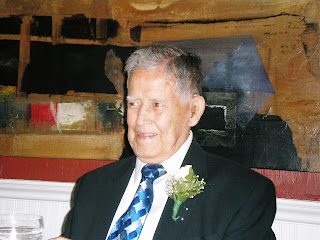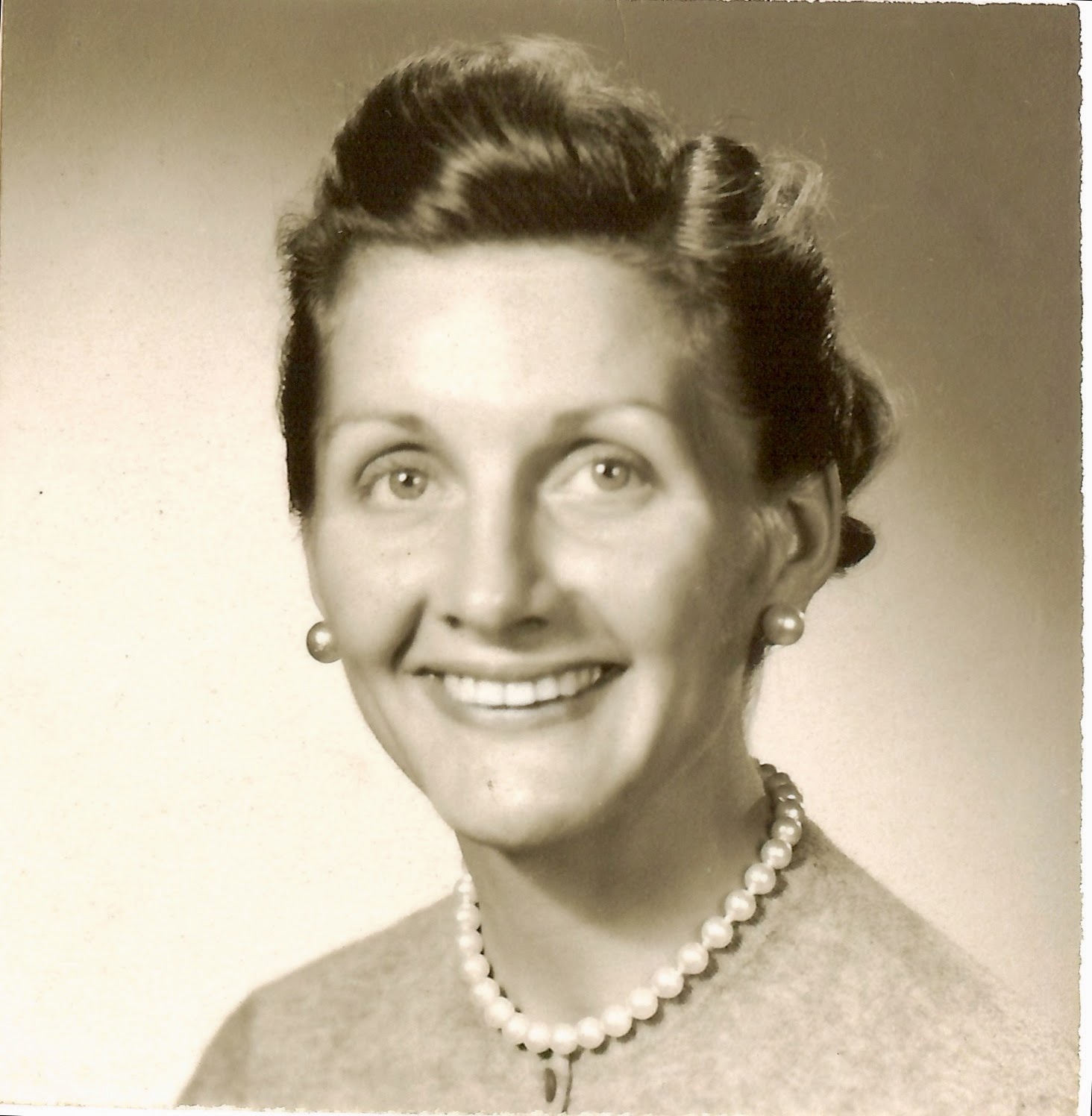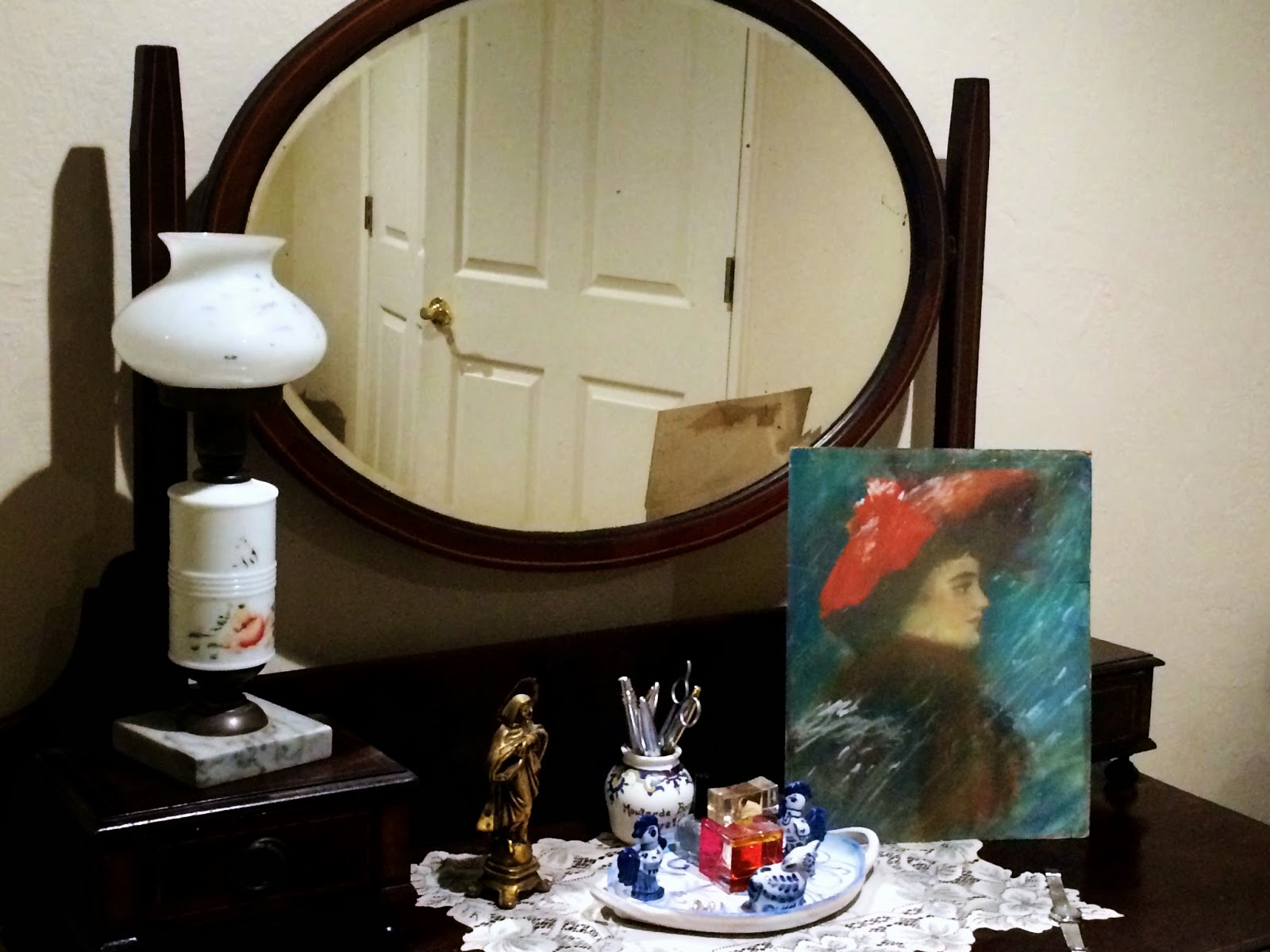Gilbert Cayetano Huesca (1915 – 2009)
 |
| Everyone knew this gentle man as Gilbert Cayetano Huesca. But to my sisters and me, he will always be our “Daddy.” |
Copyright © 2015 Linda Huesca Tully
Gilbert Cayetano Huesca (1915 – 2009)
 |
| Everyone knew this gentle man as Gilbert Cayetano Huesca. But to my sisters and me, he will always be our “Daddy.” |
Copyright © 2015 Linda Huesca Tully
Benita (McGinnis) McCormick (1889 – 1984)
| A local Bay Area feature story from the mid- 1970s depicts Benita (McGinnis) McCormick with mementos from her travels. Clipping courtesy of Suzanne Olson Wieland. |
[Note: Amanuensis is an ancient word meaning one who performs the function of writing down or transcribing the words of another. Derived from the Latin root manu- , meaning manual or hand, the word also has been used as a synonym for secretary or scribe.]
A transcription of the story follows here. (The story contains one factual error; it refers erroneously to Aunt Detty’s son as “George.” His name was Phillip, and he went by his nickname, “Bud.”
Then Just Hangs On
Artist and businesswoman, Benita McCormick, zips through life with vim and vigor. The secret of her zest is to grab hold of an idea in the same way one would grab hold of the tail of a donkey – then hang on.
It was shortly after her marriage to Phillip McCormick, a railroad executive with the Baltimore-Ohio in Chicago, that Mrs. McCormick began putting her ideas to work. Prior to that she had been too busy studying art illustration and painting at the Art Institute in Chicago and the galleries in Paris and later, working on the Chicago movie censor board.
Mrs. McCormick’s method is to take a creative idea, hammer and chisel it into the commercial world and produce a going concern.
Shortly after her marriage she got the idea of teaching children to paint to music after seeing the moods created by violinists during the rehearsal of love scenes in Hollywood.
She rented a studio in the Astor Hotel in Milwaukee, where she was then living, and began to teach the children painting to the tunes of the Teddy Bears’ Picnic and the Clock Shop. Her idea was so successful that the Milwaukee Art Institute copied her idea and installed an electric organ in their institute.
Her painting classes brought an acquaintance with the youngsters’ mothers and out of this grew her interior decorating business which was soon thriving.
The McCormicks returned to Chicago and became involved in raising their twins, Jane and George (sic). What then could be more natural than for a young mother busy at home to decide to redecorate her dining room?
So Benita set to work. She stripped the dining room of its five panels of wallpapered hunting dogs and began to paint. She painted the room in oils showing the different fairytales that would entertain the children.
| Article about Benita McCormick |
| Guests coming to the house were impressed and soon she was doing scenes for other people’s homes. One painting she did for her father, of his favorite fishing haunt, added $500 to the sale of the house.
As the children grew older and became more independent Benita turned her interest towards advertising. She got the idea of making Christmas cards that showed the different models of cars. And she soon had more orders than she could handle. The result was a studio business that ran for three years. A business enterprise that started during World War II and was to last for 16 years began when Benita dreamed up the idea of a job survey. Her idea was to call people in their homes and tell them of the job opportunities available to them. She would then send the prospective employe her card and have them present it to the personnel office that they applied to. It was a workers market in those years; there were hundreds of jobs available that employers were desperate to fill. Benita took her idea to the most conservative firm in town and won them over with a contract. At the end of 16 years of personnel work Benita decided to retire with her husband and “have some fun.” They made their base in San Mateo and began to travel. They went to Europe and fell in love with Spain where they stayed one year. After a year in California they returned to Spain and toured the Near East and the Holy Land as well. “I’m mad about Spain,” says Mrs. McCormick, “I love the people, they’re so warm and friendly. I like Barcelona best because it has a lot of life to it.” It was during her stay in Barcelona that Benita became interested in applying gold leaf to statues. She found a man in Barcelona who worked in gold leaf and became his student for five hours a day for eight months. Professor Antonio’s studio was what had once been a stable and later the carriage house of a great mansion. It had walls one foot thick that were pocked with cannon balls, a false floor and cathedral-high ceiling. Back in California, Benita applied her newly learned gold-leaf technique to making coats of arms. She first became interested in shields because she thought “it was a nice thing for people to have pride in their families.” Like all her ideas, this, too, has become an enterprising project with Benita making coats of arms for families and newly formed businesses. And the McCormick’s coat of arms is “Without Fear.” |
Benita (McGinnis) McCormick (1889 – 1984)
Phillip Columbus McCormick (1892 – 1981)
Gilbert Cayetano Huesca (1915 – 2009)
Joan Joyce (Schiavon) Huesca (1928 – 1987)
 |
| Cover of the folio containing a souvenir photograph of my parents’ and great aunt and uncle’s dinner at the Mauna Loa Restaurant, Mexico City. |
It was Holy Week, and the shop, like most others in the city, was sporting a colorful window display of its most festive creations and goodies in anticipation of Easter Sunday.
As only children could do with a loving uncle, we talked him into buying us half the candy store.
Well, maybe not that much, but it must have seemed that way to Aunt Detty when we got home, licking our sticky fingers and chasing each other around the house on a sugar high. There went her chances of getting us to eat our dinner that night!
Monkeys never had it so good.
Benita (McGinnis) McCormick (1889 – 1984)
Phillip Columbus McCormick (1892 – 1981)
Phil and Benita (McGinnis) McCormick’s love affair with Spain began in 1960, when they arrived for a couple of months and ended up living there for a year, making some of the best memories of their lives. Benita – my great-aunt Detty – also created some of her best art there. In her untitled ode to Spain below, she painted a loving picture of the country that captured her heart and sparked her imagination.
 |
| Iberian Peninsula at night, NASA, International Space Station, December 4, 2011 Creative Commons; in the public domain |
Benita (McGinnis) McCormick (1889 – 1984)
Phillip Columbus McCormick (1892 – 1981)
Copyright © 2015 Linda Huesca Tully
Benita (McGinnis) McCormick (1889 – 1984)
Phillip Columbus McCormick (1892 – 1981)
 |
| Benita and Phillip McCormick leaving El Greco Museum. Caption reads, “Recuerdo de Toledo – Casa del Greco.” “Souvenir of Toledo – Home of El Greco.” 1960, Toledo, Spain. |
Copyright © 2015 Linda Huesca Tully
Benita (McGinnis) McCormick (1889 – 1984)
Phillip Columbus McCormick (1892 – 1981)
When a letter begins with the words, “Sit down,” a big announcement is sure to follow.
That was how my great-uncle-and-aunt, Phillip and Benita (McGinnis) McCormick, learned that their daughter, Jane, had married her true love, Eldon “Ole” Olson, in a private church ceremony in Carmel-by-the-Sea, California, in May of 1960.
Reading the news in their Barcelona pension, some 5,000 miles away from home, they were undoubtedly surprised, though maybe not entirely. True, it had been easier to see their son, Bud, marry and start a family, but letting go of their daughter was tougher to do.
They had to admit that she did what they would want her to do, which was to follow her heart and do things her own way. Besides, she had tried her best to cushion the news.
 |
| Did Aunt Detty gold-leaf this small statue of the Virgin Mary? From her collection of Spanish Madonnas, it now sits on my dressing table. |
In characteristic fashion, Uncle Phil and Aunt Detty rose to the occasion. Swallowing their pride, they sent her and Ole their congratulations and decided to extend their stay a while longer. And being the larger-than-life couple they were, even in their 70s, their idea of “a while” turned into a year.
Spain, a place to retreat in a moment of uncertainty as they struggled to give their daughter some room to grow, became the place of their rebirth and rediscovery.
In a 1960 letter to my parents, Aunt Detty’s words spill out breathlessly, and she seems to abbreviate many of them to help her fingers keep up with her rapid-fire thoughts. Here, “g.l.” stands for “gold leaf,” while “E” stands for España, or Spain:
I wonder if the small statue of the Virgin Mary, shown in the picture above, is the same plaster Virgin that Aunt Detty was gold leafing? My cousin, her granddaughter Suzanne (Olson) Wieland, gave it to me a couple of years ago, one of a collection of Madonnas Aunt Detty brought back from Spain.
Evidently, her hosts were equally fascinated by their older pupil:
Each day our lesson from 4:30 pm till 8 pm is punctuated by loud rings of the bell to admit some visitor, or client, to meet the “Americana.” [The maestro’s] daughter, 14, brings her school friends and his sister-in-law came to check on me. . . . Evidently I pass muster, look harmless, and so get the welcome Española! I love them all.
Aunt Detty and Uncle Phil were especially taken by the Spaniards’ slower pace of life, their philosophy that there is always mañana – another day, and that if things don’t resolve themselves right away, they will work themselves out eventually. In the same letter to my parents, she marvels at this slower pace of life.
Joan, this is a week to the day from the start of this note…. you also know what mañana means – Mary Harlow told me that if a Spaniard says “Mañana – mañana” that really means the next day. but life is so full here – I can understand how it takes months to get things done. No wonder they think we do everything by “machinas” we move so much faster than they.
As with everything else they did, Phil and Benita McCormick wholeheartedly embraced the lifestyle of mañana. Sure enough, they gradually accepted the idea of Jane’s being married and lovingly welcomed their new son-in-law, Ole Olson.
Copyright © 2015 Linda Huesca Tully
 |
| Secret courtyard passage, Carmel-by-the-Sea |
 |
| Ole and Jane (McCormick) Olson on their wedding day, May 6, 1960, at the Church of the Wayfarer, Carmel-by-the-Sea, California. |
 |
| A congratulatory telegram from friends of Ole and Jane Olson in care of the Church of the Wayfarer, notes the wedding took place in the afternoon of May 6, 1960. |
Benita Elizabeth (McGinnis) McCormick
(1889 – 1984)
Phillip Columbus McCormick (1892 – 1981)
Phillip Eugene “Bud” McCormick (1927 – 2004)
Benita Jane “Janie” (McCormick) Olson
(1927 – 2011)
Elson “Ole” Olson (1924 – 1994)
 |
| Benita Jane McCormick, known as “Jane,” circa 1960. |
| This menu cover from Bright Angel Lodge at Grand Canyon, Arizona, hung in Jane (McCormick) Olson’s kitchen for many years, a fond memory from her days there as a Harvey Girl. |
 |
| A TWA gate agent offers his hand to Jane McCormick as she disembarks a jet on one of her many travels. |
At 32 years old, she was having the time of her life, working for a major international airline during the Golden Age of air travel. It was the same way Phil had felt during early days with the railroad in the 1920s.
In 1960, most airports were new and clean, bright places that attracted not only business and leisure travelers but also the curious who came to see what all the fuss was about. And there sure was a lot of fuss. Large concourses displayed artistic tourism posters beckoning people to see new places. Passenger lounges offered travelers and would-be travelers enormous windows to gaze through at sleek and silvery jet airplanes that promised to take them in style to see their families, or maybe even to an exotic vacation abroad, much quicker than by rail or boat. Airline employees, usually clean-cut young men and women, wore crisp uniforms, enjoyed good pay and flight benefits, and received special training in customer service, charm, and etiquette.
| Eldon “Ole” Olson, year unknown |
Passengers at the time were generally from the middle and upper classes. Decked out in smart outfits and wearing the latest hairstyles, they came to airports to see and be seen. Those traveling for pleasure were typically accompanied by large entourages of family and friends who saw them off and greeted them on their return as if they were the most important people in the world.
No wonder, then, that Jane and Ole’s courtship felt so magical, especially against this glamorous backdrop. Ole Olson was everything Jane had dreamed of: funny and bright, kind, attentive, and romantic. She could not believe the similarities between him and her father. Like Phil McCormick, Ole was fair-skinned and fair-haired and was from Minnesota. To top it off, he was a freight agent (and later supervisor of ramp services) for TWA, just as Phil had been a freight agent for the railroad.
When asked years later about those days, Ole recalled that Jane was the most beautiful woman he had ever seen. He loved her lilting laugh, the way she looked up at him through her clear blue eyes and long dark eyelashes, and the graceful way she moved through a room. He teased her about being sentimental, but he loved her for it, all the same.
It gradually became clear to Benita and Phil that their little girl was falling in love with Ole Olson. As she began spending more time with him and less time with her parents, they reluctantly had to admit that they were no longer at the center of their daughter’s life.
Sometimes love is about letting go. As much as they understood that, Phil and Benita also realized they would have to find something else to fill their new-found time. So just months after arriving in California, they closed up the apartment and obtained two one-way TWA airline passes to Barcelona, Spain, to begin the next phase of their lives.
Benita (McGinnis) McCormick (1889 – 1984)
 |
| Benita (McCormick) McGinnis drew this untitled chalk rendering in Chicago, possibly in 1931. |
With winter snow and rain storms in full force across the world this week, it seems appropriate to post this chalk drawing by my great-aunt “Detty,” Benita McCormick.
The back of this portrait contains no information to date it, but it resembles Aunt Detty’s artistic style during the early 1900s. If you look closely, you can see the outline of the thin brown wooden frame that held the portrait for decades until it fell apart in the late 1980s.
 |
| The Lady in Winter, still as beautiful as she was when Aunt Detty created her nearly a century ago, today sits contentedly on my antique dresser, a reminder of an elegant and gracious era. |
This “Lady in Winter” looks quite content here, dressed fashionably in her red wide-brimmed hat as a stray lock of her gathered-up hair catches the wind. A matching thick red scarf gently drapes around her high neck, falling softly over what looks like a fur coat so typical of middle class midwestern ladies at the time. A steady snow swirls around her as she serenely yet confidently makes her way down the street against a stormy sky, just before dusk. Her lips slightly pulled back into a near-smile, she looks straight ahead as if anticipating a pleasant event or meeting. It is easy to imagine her warming up the room when she walked in, turning heads with her fine features and rosy countenance.
She is, the more I think of it, rather a lot like Aunt Detty.
Where is she going? Who is she meeting? Only she knows. What I do know for sure, though, is that the Lady in Winter cheers me up every morning as she sits there on my dresser, reminding me that no matter what weather lies ahead, it is one’s light from within that warms the heart and cheers the soul.
************
Copyright © 2015 Linda Huesca Tully